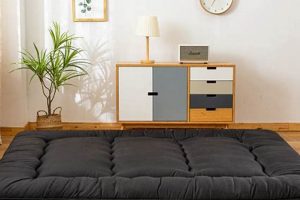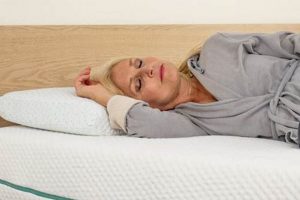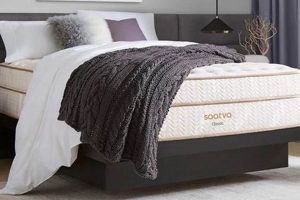Adjustable air beds, offering customizable firmness levels through integrated air chambers, represent an alternative within the sleep solutions market. These mattresses allow individuals to modify support to meet specific comfort preferences, often utilizing a remote or application to control internal air pressure.
The principal advantage of these adjustable air systems lies in their potential to accommodate varying sleep needs and partner preferences. By allowing independent zone control, each side of the bed can be adjusted to a different firmness, addressing potential discrepancies in comfort requirements. Historically, such beds have been utilized in medical settings to alleviate pressure points and promote circulation. Their entry into the consumer market has provided individuals with tools for enhanced sleep customization.
Subsequent sections will delve into specific features, technological advancements, and consumer considerations relevant to evaluating adjustable air beds and their role in the evolving landscape of sleep technology.
Optimizing the Experience with Adjustable Air Beds
Maximizing satisfaction with an adjustable air bed requires careful consideration of several factors. This section outlines essential guidelines for ensuring proper use and longevity.
Tip 1: Foundation Integrity: Prioritize a solid and level foundation. Adjustable air systems require a stable base to ensure proper support and prevent uneven air distribution. Slatted foundations should have minimal spacing between slats.
Tip 2: Gradual Inflation: When initially inflating the mattress, proceed gradually. Overfilling can stress the internal components and potentially damage the air chambers. Monitor the inflation level and adjust incrementally.
Tip 3: Remote Control Mastery: Familiarize oneself with the remote control or application interface. Understanding the controls is crucial for accurately adjusting firmness levels and utilizing any available features, such as zone control.
Tip 4: Regular Monitoring: Periodically check the air pressure in each chamber. Slight variations may occur over time. Correcting any imbalances promptly ensures consistent support and comfort.
Tip 5: Protective Measures: Employ a mattress protector designed for adjustable air beds. This safeguards the mattress from spills, stains, and general wear and tear, extending its lifespan.
Tip 6: Partner Communication: Open communication with a sleeping partner is vital for optimal comfort. Collaborate on adjusting firmness levels to accommodate individual preferences and address any discomfort.
Tip 7: Professional Consultation: For individuals with specific medical conditions or chronic pain, consulting with a healthcare professional or sleep specialist is recommended. They can offer personalized guidance on mattress selection and adjustment.
Adhering to these recommendations will contribute to a more comfortable and supportive sleep environment, potentially improving sleep quality and overall well-being.
The subsequent concluding remarks will synthesize the information presented and offer final thoughts on the value of adjustable air beds within the broader context of sleep technology.
1. Customizable Firmness
Customizable firmness represents a pivotal characteristic of adjustable air beds. This adaptability allows for the modification of the sleep surface to accommodate individual comfort preferences and evolving physical needs, positioning these systems as potential alternatives within the sleep solutions market.
- Individualized Support Adjustment
Adjustable air beds facilitate personalized support through independent air chambers. Users can fine-tune the internal pressure to achieve desired firmness, addressing specific areas of discomfort or optimizing spinal alignment. This contrasts with traditional innerspring or foam mattresses, which offer a fixed level of support.
- Accommodation of Changing Needs
Firmness requirements may fluctuate due to injury, pregnancy, or weight fluctuations. Adjustable air systems permit real-time modifications to meet these evolving needs, potentially prolonging the lifespan of the mattress and reducing the need for frequent replacements. Consider, for example, an individual recovering from back surgery requiring a softer surface during initial healing, with gradual increases in firmness as rehabilitation progresses.
- Partner Preference Discrepancies
In shared beds, disparities in firmness preferences are common. Adjustable air systems, often equipped with dual-zone control, enable each partner to independently customize their side of the mattress. This feature mitigates potential conflicts and promotes more restful sleep for both individuals. Real-world scenarios often involve one partner preferring a firmer surface for back support, while the other favors a softer feel for pressure relief.
- Impact on Sleep Quality
Optimal firmness is a determinant of sleep quality. An improperly firm or soft mattress can exacerbate pressure points, leading to tossing and turning, and disrupting sleep cycles. The ability to precisely adjust firmness minimizes these disturbances, potentially leading to improved sleep duration and quality, and reduced sleep-related discomfort.
The inherent adaptability of adjustable air systems, particularly their capacity for customizable firmness, distinguishes them within the broader spectrum of mattress options. This feature addresses the inherently subjective nature of sleep comfort, positioning these beds as potentially valuable investments for individuals seeking personalized sleep experiences.
2. Dual-Zone Control
Dual-zone control, a feature frequently associated with adjustable air bed systems, represents a significant advancement in personalized sleep technology. Its presence directly addresses the challenge of accommodating disparate sleep preferences within shared sleeping spaces, offering a customizable solution tailored to individual needs.
- Independent Firmness Adjustment
Dual-zone control enables independent adjustment of firmness levels on each side of the mattress. This functionality allows partners to select their preferred support without compromising the other’s comfort. For example, an individual requiring firmer support for spinal alignment can maintain a higher air pressure on their side, while their partner can opt for a softer feel for pressure relief. This isolation of adjustment avoids the common scenario of one partner sacrificing their sleep quality to accommodate the other’s needs.
- Mitigation of Motion Transfer
Beyond firmness, dual-zone systems can also contribute to reduced motion transfer. By isolating air chambers, movement on one side of the bed is less likely to disturb the other. This is particularly relevant for individuals with differing sleep schedules or those prone to restlessness during the night. The compartmentalized design minimizes the transmission of movement, promoting uninterrupted sleep for both partners.
- Customized Therapeutic Support
Dual-zone control facilitates targeted therapeutic support for individuals with specific medical conditions. For instance, a person recovering from an injury may require a different level of support than their partner. Independent adjustability allows for tailored pressure distribution and contouring to alleviate pain and promote healing. Consultation with a healthcare professional is recommended to determine the optimal firmness settings for such therapeutic applications.
- Technological Integration
Many dual-zone control systems incorporate advanced technology, such as remote controls, smartphone applications, and biometric sensors. These integrations offer enhanced control, data tracking, and personalized recommendations. Users can monitor their sleep patterns, adjust firmness levels remotely, and receive insights into optimal sleep settings. This technological augmentation further refines the sleep experience and empowers individuals to actively manage their sleep environment.
In conclusion, dual-zone control is a critical element in the architecture of advanced adjustable air bed systems. Its ability to independently address firmness preferences, mitigate motion transfer, and facilitate customized therapeutic support underscores its value in promoting personalized and optimized sleep experiences for cohabitating individuals.
3. Pressure Point Relief
Pressure point relief is a primary objective for consumers seeking mattresses designed to enhance sleep comfort. Adjustable air beds, with their ability to customize firmness, directly address this concern. Pressure points occur when the body’s weight is concentrated over small areas, such as the shoulders and hips, restricting blood flow and causing discomfort. The adjustability inherent in air bed systems allows users to redistribute weight more evenly across the sleep surface, minimizing pressure concentration. As an example, an individual experiencing hip pain may lower the air pressure in the corresponding chamber to create a softer, more conforming surface, thus alleviating pressure on the affected area.
The efficacy of pressure point relief in adjustable air beds is contingent upon proper adjustment. Over-inflation can negate the benefits by creating a rigid surface that fails to conform to the body’s contours. Conversely, insufficient inflation may lead to excessive sinking, compromising spinal alignment. Consequently, a gradual, iterative approach to firmness adjustment, guided by personal comfort and, when possible, professional medical advice, is crucial. The customization capabilities extend potential benefits to individuals with conditions such as arthritis or fibromyalgia, where pressure sensitivity is heightened. By fine-tuning air chamber settings, individuals can mitigate discomfort and potentially improve sleep quality.
In summary, pressure point relief is a key selling point for adjustable air bed systems. Its effectiveness hinges on the user’s ability to properly adjust the mattress to their individual needs. Understanding the relationship between air pressure, body weight distribution, and individual comfort preferences is paramount for maximizing the potential benefits of these systems. Challenges remain in achieving optimal firmness settings, underscoring the importance of informed decision-making and ongoing adjustment based on personal experience and potential medical recommendations.
4. Foundation Requirements
Proper foundation support is a critical, yet often overlooked, aspect of optimizing the performance and longevity of adjustable air bed systems. The structural integrity of the foundation directly impacts air distribution within the mattress chambers, affecting both comfort and long-term durability. Deviation from recommended foundation guidelines can lead to uneven support, premature wear, and potential damage to the air chambers.
- Solid and Level Surface
Adjustable air beds require a uniformly flat and level surface. Uneven surfaces compromise the distribution of air within the chambers, leading to inconsistent support and potential pressure points. A solid platform bed or a reinforced box spring are typically suitable options. In contrast, slatted foundations with wide gaps or sagging surfaces can create stress points and compromise the mattress’s structural integrity. The absence of a level surface can result in a compromised sleep experience and reduced product lifespan.
- Weight Distribution Considerations
The foundation must be capable of supporting the combined weight of the mattress and its occupants. Exceeding the foundation’s weight capacity can lead to structural failure, resulting in uneven support and potential damage to the mattress. For larger adjustable air bed models or those intended for heavier individuals, a reinforced foundation is recommended. A properly rated foundation ensures consistent support across the entire mattress surface.
- Compatibility with Adjustable Bases
Adjustable bases, which allow for customized elevation of the head and feet, are frequently paired with adjustable air beds. However, compatibility is essential. The air bed must be designed to articulate without compromising the air chambers or internal components. Incorrect pairing can lead to damage and voiding of warranties. Prior to combining an adjustable air bed with an adjustable base, verifying compatibility specifications is necessary.
- Impact on Warranty Coverage
Most adjustable air bed manufacturers stipulate specific foundation requirements within their warranty terms. Failure to adhere to these requirements can void the warranty, leaving the consumer responsible for repair or replacement costs. Carefully reviewing the warranty documentation and selecting a compatible foundation is crucial for protecting the investment and ensuring recourse in the event of product defects.
In conclusion, the foundation plays a pivotal role in the performance and longevity of adjustable air beds. Adherence to manufacturer-specified foundation guidelines is essential for maintaining proper support, preventing damage, and preserving warranty coverage. Investing in a compatible and structurally sound foundation is a prerequisite for realizing the full potential of an adjustable air bed system.
5. Air Chamber Integrity
Air chamber integrity is paramount to the functionality and lifespan of adjustable air beds. The air chambers are the core component responsible for providing customizable support, and their condition directly impacts the bed’s ability to deliver consistent and reliable performance. Compromised air chamber integrity can lead to air leaks, uneven support, and ultimately, product failure.
- Material Composition and Durability
The materials used in constructing the air chambers directly influence their resistance to punctures, tears, and degradation over time. High-quality, reinforced polymers are generally employed to enhance durability and prevent air leakage. Thinner, less robust materials are more susceptible to damage from internal pressure and external factors such as improper handling or sharp objects. For example, a chamber constructed from multi-layered, reinforced fabric offers greater protection compared to a single-layer vinyl construction.
- Seam Construction and Reinforcement
The seams that join the various sections of the air chamber represent potential weak points. Robust seam construction techniques, such as heat welding or reinforced stitching, are essential for maintaining airtight seals. Weak or poorly constructed seams are prone to failure under pressure, leading to gradual air leaks and a loss of support. Regular inspection of the seams for signs of separation or wear is recommended to identify potential problems early.
- Valve Design and Functionality
The air valves, responsible for inflation and deflation, must maintain a secure and airtight seal to prevent air loss. Valve design and the quality of the sealing mechanism directly impact the rate of air leakage. Malfunctioning valves can result in gradual or rapid deflation, compromising the adjustability of the mattress and leading to discomfort. Periodic inspection and maintenance of the valves are necessary to ensure proper functionality and prevent air loss.
- Impact of Environmental Factors
Environmental conditions, such as temperature fluctuations and humidity, can influence the integrity of the air chambers. Extreme temperatures can cause the materials to expand or contract, potentially weakening seams and compromising the valve seals. High humidity levels can promote the growth of mold and mildew, which can degrade the materials over time. Maintaining a stable and dry environment is recommended to prolong the lifespan of the air chambers.
The interplay of material quality, seam construction, valve design, and environmental conditions collectively determines the air chamber integrity of adjustable air beds. Maintaining the integrity of these chambers is essential for ensuring consistent support, longevity, and overall user satisfaction. Regular inspection, proper handling, and adherence to manufacturer recommendations are crucial for maximizing the lifespan of the air chambers and safeguarding the investment in an adjustable sleep system.
6. Longevity and Maintenance
The longevity of adjustable air beds is directly correlated with consistent and appropriate maintenance practices. These beds, characterized by their customizable air chambers, require a proactive approach to preserve their structural integrity and performance over time. Neglecting maintenance protocols can lead to premature degradation of the air chambers, compromised valve function, and a diminished ability to provide consistent support. As an example, consistent adherence to recommended inflation levels prevents over-stressing the internal components, mitigating the risk of air leaks. Similarly, utilizing a mattress protector shields the bed from spills and stains, thereby preventing material degradation that could compromise air chamber integrity.
Routine maintenance involves several key procedures. Regular inspection for potential air leaks around seams and valves allows for timely intervention. Minor leaks can often be addressed with repair kits, preventing further damage. Rotating the mattress periodically promotes even wear and prevents localized stress concentration. Furthermore, vacuuming the mattress surface removes dust and debris that can abrade the fabric over time. The frequency of these maintenance activities impacts the lifespan of the adjustable air bed. A bed diligently maintained is likely to provide consistent support and comfort for an extended period, whereas a neglected bed may exhibit performance decline within a shorter timeframe.
In summary, longevity in adjustable air beds is not inherent but rather a consequence of conscientious maintenance. Consistent adherence to recommended practices safeguards the air chambers, valves, and overall structural integrity of the mattress. This proactive approach preserves the bed’s ability to deliver customizable support and comfort over an extended period, maximizing the value of the initial investment. Understanding the connection between maintenance and longevity is crucial for consumers seeking a durable and reliable adjustable sleep solution.
Frequently Asked Questions
The following addresses common inquiries regarding adjustable air bed systems, providing factual information to facilitate informed decision-making.
Question 1: What is the typical lifespan of an adjustable air bed?
The lifespan of an adjustable air bed varies depending on factors such as construction quality, usage patterns, and maintenance practices. Generally, a well-maintained system can last between 8 to 10 years. Air chamber integrity and pump performance are key determinants.
Question 2: How do adjustable air beds compare to traditional innerspring mattresses in terms of back support?
Adjustable air beds offer customizable back support due to their adjustable air chambers. This allows for individualized firmness settings, potentially providing more tailored support than traditional innerspring mattresses, which offer a fixed level of firmness.
Question 3: Are adjustable air beds suitable for individuals with allergies?
Adjustable air beds themselves do not inherently offer hypoallergenic properties. However, the use of hypoallergenic mattress protectors can mitigate allergen exposure. Individuals with severe allergies should consult with a healthcare professional before purchasing any mattress.
Question 4: What is the recommended procedure for cleaning an adjustable air bed?
Cleaning an adjustable air bed involves regular vacuuming to remove dust and debris. Spills should be addressed promptly with a mild detergent and water solution, avoiding excessive moisture. Consult the manufacturer’s guidelines for specific cleaning recommendations.
Question 5: What are the potential drawbacks of adjustable air beds?
Potential drawbacks include the risk of air leaks, pump malfunctions, and the need for a stable and level foundation. The initial cost can also be higher compared to some traditional mattress options.
Question 6: Are replacement parts readily available for adjustable air beds?
The availability of replacement parts varies depending on the manufacturer and model. It is advisable to inquire about parts availability before purchase. Maintaining warranty documentation is crucial for facilitating potential repairs or replacements.
Proper maintenance and informed selection are critical for optimizing the performance and longevity of adjustable air bed systems.
The subsequent concluding remarks will synthesize the information presented and offer final thoughts on the value of adjustable air beds within the broader context of sleep technology.
Concluding Remarks
The preceding exploration of adjustable air beds has elucidated the core features, benefits, and considerations surrounding these systems. Key aspects such as customizable firmness, dual-zone control, pressure point relief, foundation requirements, air chamber integrity, and longevity were examined in detail. Furthermore, common inquiries were addressed to provide consumers with actionable information for informed decision-making. The intent has been to offer a comprehensive overview of adjustable air beds within the broader context of sleep technology.
As the landscape of sleep solutions continues to evolve, individuals are encouraged to critically evaluate their specific needs and preferences when selecting a mattress. The unique characteristics of adjustable air beds warrant careful consideration for those prioritizing personalized comfort and support. Further research and consultation with sleep specialists may be beneficial in determining the suitability of such systems for individual circumstances. The ultimate goal remains the attainment of restful and restorative sleep, irrespective of the chosen technology.






![Top-Rated Best Sleeping Mattress for Camping: [Year] Guide Organic & Natural Mattress Buyer’s Guide: Non-Toxic Sleep Solutions Top-Rated Best Sleeping Mattress for Camping: [Year] Guide | Organic & Natural Mattress Buyer’s Guide: Non-Toxic Sleep Solutions](https://mattressworldpa.com/wp-content/uploads/2025/07/th-1737-300x200.jpg)
